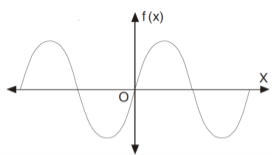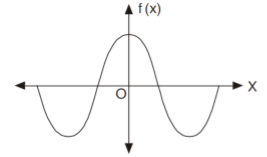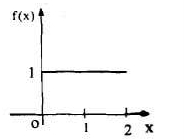Unit - 2
Fourier Series & Fourier Transform
Q1) What is Periodic function?
A1)
Periodic function
If the value of the function (y-axis) repeats itself on x-axis, then the function is called periodic function.
Suppose f(x) is a function, then
If f(x) = f(x + t) = f (x + 2t) = …………….
Then t is called the periodic of the function f(x).
Suppose if we take sin x, then it repeats its value after the period of 2 such that, we write this as
such that, we write this as
Sin x = sin (x + 2π) = sin ( x + 4π) ………….
We can say that sin x is a periodic function with the period of 2π.
Note-
- Cos x, sinx , sex x, cosec x are periodic functions with period 2π.
- Tan x and cot x are periodic with period π
- Suppose T is the period of f(x) then nT is also periodic of f for any integer n.
Some important integrals:







A series of the form,

Is called fourier series , where
 are constants.
are constants.
Any periodic function can be expanded in the form of fourier series.
Determination of  ,
,  ,
,  of Fourier series-
of Fourier series-
We know that, the fourier series,
f(x) =  ------------ eq.(1)
------------ eq.(1)
To find  –
–
Intergrate equation (1) on both sides, from 0 to 2π

Which gives,


To find  -
-
Multiply each side of eq. (1) by cos nx and integrate from 0 to 2π
We get,



Similarly we can find  by, multiplying eq. (1) by sin nx and integrating from 0 to 2π
by, multiplying eq. (1) by sin nx and integrating from 0 to 2π

Q2) Find the fourier series of the function f(x) = x where 0 < x < 2 π
A2)
We know that, from fourier series,

First we will find  ,
,

Now, 


And  ,
,


Put these value in Fourier series, we get

Q3) Find the Fourier series of

Which is assumed to be periodic with period 2π
A3)
The Fourier series is given by-

Here


Now


Integrating by parts,


Similarly we get,


Substituting a0, an and bn we get the required Fourier series of f (x) in the internal (−π, π ) as


Which is the required answer.
Q4) Find the Fourier series for f(x) = x / 2 over the interval 0 < x < 2π
And has period 2π
A4)
First we will find

= 
=
= π
 = π
= π
Similarly,





Which gives,  = 0
= 0
Now,





We get, 
We know that, the Fourier series

Put these values in Fourier series, we get


Q5) Find the Fourier series for f(x) =  in the interval
in the interval  .
.
A5)
Suppose

Then-

And


So that-


And then-




Now put these value in equations (1), we get-

Q6) Explain Even and odd functions
A6)
Fourier series of even and odd function
Odd function-
A function f(x), which is written as,
f( - x ) = - f(x)
Is known as odd function.
The graph of the odd function looks like-

The graph of the function is symmetric about x-axis.
And the area under the curve from -π to π is always zero.(see fig)

Even function-
If f(-x) = f(x) then the function is known as even function.
The graph of the function f(x) looks like-

Area under the curve from -π to π will always be double the area from 0 to π

Expansion of an even function-


Here cosnx and f(x) are both even functions.
As we know that the product of two even numbers will be even.
Such as product of f(x) and cosnx will always be even.
Now,

Here we see that sin nx is an odd function.
So that we do not need to find 
That means the series of an even function contains cosine terms only.
Expansion of an odd function-



The series of the odd function contains only sine terms.
Q7) Find the Fourier expression of f(x) = x³ for –π< x <π.
A7)
Here, we can see that f(x) Is an odd function
So that,
 and
and

We will use here ,



We get the value of f(x),

Q8) Find the Fourier series expansion of the periodic function of period 2π.
f(x) = x², -π≤x≤π
A8)
The given function is even, so that,

We will find 





The fourier series will be ,
f(x) = a0/2 + a1 cos x + a2 cos 2x + a3 cos 3x + . . . + an cos nx + . . .

Q9) Find the Fourier series corresponding to the function f (x) defined in ( –2, 2) as follows

A9)
Here the interval is ( –2, 2) and c = 2













Q10) Find a Fourier series for
f(x) = x2 - 2 -2 ≤ x ≤ 2
A10)
Here
f(x) = x2 – 2 ; -2 ≤ x ≤ 2
Since f(x) is even function hence bn = 0
 It’s Fourier series is
It’s Fourier series is
f(x) = a0/2 + 
Where
a0 = 2/2 
= 
= 
= [ 8/3 – 4 – 0 ]
= - 4/3

= 
= 
= 
= 
Hence equation (1) becomes,

Q11) Find half range cosine series of f(x) = x(π – x) in the interval (0, π) and hence deduce that
a) 
b) 
A11)
Here
f(x) = x(π – x); (0, π)
Hence it’s half range cosine series is,
f(x) = a0/2 + 
Where
a0 = 2/π 
= 2/π 
= 2/π 
= 2/π [ π3/2 – π3/3 – 0]
= 2/π [ π3/6]
= π2/3
a0 = 2/π 
= 2/π 
= 2/π 
= 2/π [ -π 
= -2 [ (1 + (-1)n)/n2]
Hence equation (1) becomes,

= π2/6 – 2 [ 2/22 cos 2x + 2/42 cos 4x + 2/62 cos 6x+ …..]
= π/6 – 4 [ cos 2x/22 + cos 4x/42 + cos 6x/62 + …..] …..(2)
Put x = 0, we get
0 = π2/6 – 4 [ ½2 + 1/42 + 1/62 + …..]
π2/6 = 1/12 + ½2 + 1/32 + …..
Hence the result
Put x = π/2 we get,
π2/4 = π2/6 – 4 [ -1/22 + 1/42 - 1/62 + …..]
i.e. π2/12 = 1/12 – ½2 + 1/32 – ¼2 + ….
Q12) Find the Fourier sine series for the function-

Where ‘a’ is a constant.
A12)
Here we know-


We know that-




And


Q13) What are the Properties of Fourier transform?
A13)
Property-1: Linear property- If F(s) and G(s) are two Fourier transforms of f(x) and g(x) respectively, then-
F[af(x) + bg(x)] = aF(s) + bG(s)
Where a and b are the constants.
Property-2: Change of scale- If F(s) is a Fourier transform of f(x), then

Property-3: Shifting property- If F(s) is a Fourier transform of f(x), then

Property-4: Modulation- If F(s) is a Fourier transform of f(x), then

Q14) Find the Fourier transform of-

Hence evaluate 
A14)
As we know that the Fourier transform of f(x) will be-

So that-

For s = 0, we get- F(s) = 2
Hence by the inverse formula, we get-

Putting x = 0, we get

So-

Q15) Find the Fourier transform of  , a< 0
, a< 0
A15)
As we know that the Fourier transform of f(x) will be-

So that-


Now put 

So that-

Q16) What is Fourier integral theorem?
A16)
If f∈S(R), then

Proof:
We first claim that

Let  , By the multiplication formula we get
, By the multiplication formula we get

Since Kδ is a good kernel, n the first integral goes to f(0) as δ tends to 0.Since the
Second integral clearly converges to  as δ tends to 0 ,our claim is proved .
as δ tends to 0 ,our claim is proved .
In general , let F(y)=f(y+x) so that

Q17) Find the fourier integral representation of the function

A17)
The graph of the function is shown in the below figure satisfies the hypothesis of
Theorem -1 . Hence from Eqn,(5) and (6), we have





Substituting these coefficients in Eqn.(4) we obtain




This is the Fourier integral representation of the given function.
Q18) Find the Fourier integral representation of the function

A18)
The graph of the given function is shown in the below figure . Clearly, the given function f(x) is an even function. We represent f(x) by the fourier cosine integral . We obtain




And thus ,
